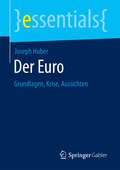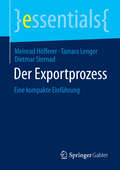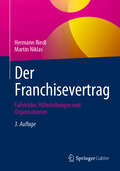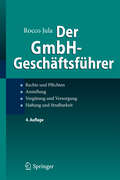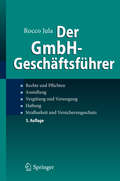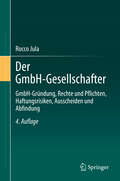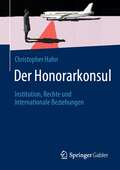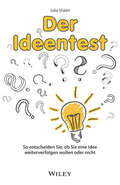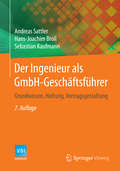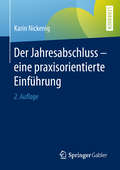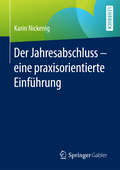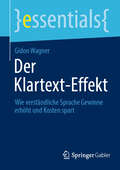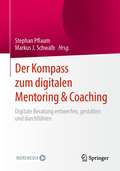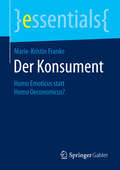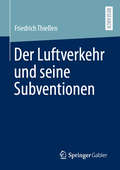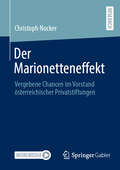- Table View
- List View
Der Euro: Grundlagen, Krise, Aussichten (essentials)
by Joseph HuberJoseph Huber analysiert die Euro-Problematik unter geld- und finanzwirtschaftlichen ebenso wie politisch-institutionellen und kulturellen Aspekten. Er geht dabei dem Paradoxon auf den Grund, dass der Euro Katalysator f#65533;r Stabilit#65533;tspolitik und eine 'immer engere Union' unter den Mitgliedstaaten h#65533;tte werden sollen, stattdessen aber von schlechten alten Gewohnheiten gekapert wurde und die s#65533;dlichen und n#65533;rdlichen Eurol#65533;nder in einer neonationalistischen Konfrontation entzweit hat. Die W#65533;hrungsunion steht heute am Scheideweg zwischen einem Niedergang in einer fortgesetzten Schulden- und Haftungsunion oder einem Neustart des Euro, der die Nichtbeistandsregel (No Bailout) wieder in ihr Recht setzt, die nationale Verantwortung f#65533;r nationale Schulden durchsetzt und das Eurosystem in wichtigen Punkten reformiert.
Der Europäische Emissionshandel: Ein Klimainstrument schreibt Industriegeschichte – Überblick, Zusammenhänge & Ausblick
by Marcel Linnemann Constanze AdolfDas Buch richtet sich an ein breites Publikum, darunter Politiker, Entscheidungsträger, Wissenschaftler und Interessierte, die ein Verständnis für die Funktionsweise des Emissionshandelssystems sowie seine Auswirkungen auf die Energiewende und die Industrie in Europa erlangen möchten. Es bietet eine sachliche Analyse und einen schnellen aber fundierten Einblick in die komplexe Thematik, um einen fundierten Diskurs über die Effektivität und die Herausforderungen des Emissionshandels zu ermöglichen.
Der Exportprozess: Eine kompakte Einführung (essentials)
by Dietmar Sternad Meinrad Höfferer Tamara LengerNeben derAuswahl der richtigen Zielmärkte, der geeigneten Form des Markteintritts und einer klaren Marktbearbeitungsstrategie hängt der Erfolg der internationalen Geschäftstätigkeit wesentlich von der Fähigkeit eines Unternehmens ab, die grenzüberschreitende Warenlieferung reibungslos abzuwickeln. In diesem Essential wird der konkrete Ablauf des Exportprozesses dargestellt, in welchem die Exportpreiskalkulation ebenso berücksichtigt wird wie umsatzsteuer- und zollrechtliche Aspekte. Neben der innergemeinschaftlichen Lieferung (dem Warenverkehr zwischen Mitgliedsstaaten der Europäischen Union) und der Ausfuhr in Drittländer werden auch die Spezifika des Dienstleistungsexports sowie jene des innergemeinschaftlichen Erwerbs bzw. des Importes aus Drittländern behandelt.
Der Forscher als Marke: Die einzigartige Forscherpersönlichkeit erkennen, positionieren und kommunizieren (essentials)
by Georg Adlmaier-Herbst Annette MayerDie meisten Forscher wissen nicht, wie sie sich optimal präsentieren können. Dieses Buch stellt vor, wie Sie Ihre einzigartige Forscherpersönlichkeit definieren, gegen andere abgrenzen und als authentische Eigendarstellung gestalten können.Warum ist das Thema für Forscher so wichtig? Zunehmend müssen sie sich im akademischen Umfeld klar und deutlich positionieren und in der Öffentlichkeit überzeugend präsentieren – sei es aufgrund von Wettstreit bei Stellenbesetzungen, Kampf um Fördergelder, kritischen Fragen der Öffentlichkeit über den Sinn von Forschung.
Der Franchisevertrag: Fallstricke, Hilfestellungen und Organisationen
by Hermann Riedl Martin NiklasDieses Buch orientiert sich an vielen Erfahrungen aus der Praxis im Bereich Recht und Unternehmenssteuerung und den daraus resultierenden Problemstellungen, teilweise auch anderweitiger Rechtsprechung soweit sie sich direkt auf franchiserelevante Fragestellungen bezieht, oder zumindest dort analog anwendbar ist. Der Darstellung verschiedener Gestaltungsmöglichkeiten schließen sich dann Gedanken hinsichtlich der Konsequenzen für das operative Geschäft an, einerseits hinsichtlich einer Vermeidung von Konflikten im Rahmen der Systemgestaltung, andererseits hinsichtlich konkreter Lösungsmöglichkeiten. Dieses Buch bietet natürlich kein vollständiges Bild des Franchiserechts in Deutschland. Auch kann keinerlei Gewähr für eine Vollständigkeit und für eine erhoffte Rechtssicherheit übernommen werden. Insgesamt ergibt sich jedoch in der Zusammenschau ein breit gefächertes Bild eines Franchisevertrages und der möglichen operativer Lösungen aus den Bereichen Handel, Retail, Gastronomie, Handwerk, Beratung und anderen Dienstleistungszweigen.
Der Franchisevertrag: Fallstricke, Hilfestellungen und Organisationen
by Hermann Riedl Martin NiklasDieses Buch orientiert sich an vielen Erfahrungen aus der Praxis im Bereich Recht und Unternehmenssteuerung und den daraus resultierenden Problemstellungen, teilweise auch anderweitiger Rechtsprechung soweit sie sich direkt auf franchiserelevante Fragestellungen bezieht, oder zumindest dort analog anwendbar ist. Der Darstellung verschiedener Gestaltungsmöglichkeiten schließen sich dann Gedanken hinsichtlich der Konsequenzen für das operative Geschäft an, einerseits hinsichtlich einer Vermeidung von Konflikten im Rahmen der Systemgestaltung, andererseits hinsichtlich konkreter Lösungsmöglichkeiten. Dieses Buch bietet natürlich kein vollständiges Bild des Franchiserechts in Deutschland. Auch kann keinerlei Gewähr für eine Vollständigkeit und für eine erhoffte Rechtssicherheit übernommen werden. Insgesamt ergibt sich jedoch in der Zusammenschau ein breit gefächertes Bild eines Franchisevertrages und der möglichen operativer Lösungen aus den Bereichen Handel, Retail, Gastronomie,Handwerk, Beratung und anderen Dienstleistungszweigen.
Der GmbH-Geschäftsführer
by Rocco JulaDie Kenntnis der rechtlichen Rahmenbedingungen ist für Geschäftsführer unerlässlich, wenn sie ihre Aufgaben ordnungsgemäß erfüllen und Handlungsspielräume effektiv nutzen wollen. In dem Band werden zunächst die wichtigsten Aufgaben und ihre rechtlichen Grundlagen erläutert. Im zweiten Teil des Ratgebers steht der Anstellungsvertrag im Mittelpunkt, haftungs- und strafrechtliche Folgen werden im dritten Teil detailliert dargestellt. Die Neuauflage berücksichtigt die GmbH-Reform nach dem MoMiG. Mit Fallbeispielen, Tipps und Vertragsmustern.
Der GmbH-Geschäftsführer: Rechte und Pflichten, Anstellung, Vergütung und Versorgung, Haftung, Strafbarkeit und Versicherungsschutz
by Rocco JulaDie Kenntnis der rechtlichen Rahmenbedingungen ist für Geschäftsführer unerlässlich, wenn sie ihre Aufgaben ordnungsgemäß erfüllen und Handlungsspielräume effektiv nutzen wollen. In dem Band werden zunächst die wichtigsten Aufgaben und ihre rechtlichen Grundlagen erläutert. Im zweiten Teil des Ratgebers steht der Anstellungsvertrag im Mittelpunkt, haftungs- und strafrechtliche Folgen werden im dritten Teil detailliert dargestellt. Die Neuauflage berücksichtigt die GmbH-Reform nach dem MoMiG. Mit Fallbeispielen, Tipps und Vertragsmustern.
Der GmbH-Gesellschafter: GmbH-Gründung, Rechte und Pflichten, Haftungsrisiken, Ausscheiden und Abfindung
by Rocco JulaGesellschafter einer GmbH sind mehr als bloße Kapitalanleger, sie haben Rechte, aber auch Pflichten. Der Autor stellt die zivilrechtliche Verantwortlichkeit anhand von Beispielen anschaulich dar und gibt entsprechende Tipps. Erheblicher Beratungsbedarf besteht bereits im Vorfeld der GmbH-Gründung: Ist die Rechtsform der GmbH für das Projekt geeignet? Wie gestalte ich den Gesellschaftsvertrag? GmbH-Gesellschafter interessieren sich häufig für Fragen der Anteilsübertragung sowie der Abfindung. Auch hier ist dieser Band ein zuverlässiger Berater.
Der Hashtag als interdisziplinäres Phänomen in Marketing und Kommunikation: Sprache, Kultur, Betriebswirtschaft und Recht
by Matthias Johannes Bauer Miriam GoetzDas Hashtagging, also der Prozess, Hashtags zu setzen, ist ein noch recht neuartiger Prozess der digitalen Verschlagwortung. Die Funktion des Hashtags geht dabei weit über den ursprünglichen Zweck der Verschlagwortung hinaus: Grundsätzlich ist der Hashtag zunächst tragendes Element gegenwärtiger politischer Debatten- und Diskussionskultur. Darüber hinaus hat er eine prominente Rolle im heutigen Marketing eingenommen: Zu nennen sind die bereits existierenden Hashtags einerseits, die die Marketer als Trittbrettfahrer nutzen. Andererseits wird angestrebt, möglichst einzigartige und profilgebende Begriffe und Neuschöpfungen im Hashtag-Marketing zu finden. Im Kampagnenmanagement müssen heute nicht nur juristische Aspekte, sondern auch Shitstorms und Hashtag-Hijacking als Risikofaktoren in Betracht gezogen werden. Bei der sprachlichen Kreation von Hashtags kommen spezifische Regeln zum Tragen, die teils linguistischen Normen folgen, teils aber auch bewusst gegen diese verstoßen oder sogar verstoßen müssen. Hashtags können sich auf ein extrem breit gefächertes Thema beziehen, allgemeingültig oder austauschbar sein. Dann liefert die Suche nach Hashtags kaum zielführende Ergebnisse. Dem stehen Hashtags gegenüber, die so dezidiert und speziell sind, dass sie für einen Großteil der Nutzer des jeweiligen sozialen Mediums irrelevant sind. Die Buchbeiträge zeigen die Größe des Spannungsfelds des Phänomens Hashtag sowie den aktuellen Forschungsstand aus unterschiedlichen disziplinären Blickwinkeln. Sie behandeln Problemstellungen, eröffnen weiterführende Forschungsansätze und nennen Beispiele aus der Unternehmenspraxis.
Der Haushalt der Europäischen Union und die deutsche Europapolitik
by Peter BeckerAlle sieben Jahre bestimmt der Streit über den EU-Haushalt die europäische Politik. Im Jahr 2011 ist es wieder soweit, wenn die Verhandlungen über den Finanzrahmen der EU für den Zeitraum 2014 bis 2020 beginnen werden und über Sinn und Zweck der Gemeinsamen Agrarpolitik und der EU-Strukturfonds debattiert wird. Hinter allem steht stets die Frage nach dem nationalen Nettosaldo – also, wie viel muss ein Staat nach Brüssel in das EU-Budget abführen, und wie viel fließen davon wieder zurück? Das Buch beleuchtet dieses Dickicht unterschiedlicher Interessen und zeichnet die Entstehung dieses höchst komplexen Systems aus Einzahlungen und Rückflüssen nach, mit besonderem Blick auf die deutsche Europapolitik.
Der Honorarkonsul: Institution, Rechte und internationale Beziehungen
by Christopher HahnZur Tätigkeit und den Aufgaben eines Honorarkonsuls bestehen im deutschsprachigen Raum nur wenige Veröffentlichungen. Dabei handelt es sich beim Honorarkonsul um ein seit dem Altertum gewachsenes Amt, dem gerade in den heutigen Zeiten der Globalisierung bei gleichzeitig wieder voranschreitender Regionalisierung eine erhebliche Bedeutung zukommt.Auch ist mit zahlreichen Klischees aufzuräumen, die mit Honorarkonsuln assoziiert werden. Honorarkonsuln werden in Deutschland in einem völker- und gewohnheitsrechtlich erprobten Verfahren bestellt und schließlich von der Bundesregierung akkreditiert. Nur so wird gewährleistet, dass sie den Aufgaben, die das Wiener Übereinkommen über konsularische Beziehungen (WÜK) wie auch die aktuelle Praxis vorsehen, gerecht werden können.Diese im deutschen Sprachraum bislang so einzigartige, allein auf das Honorarkonsularwesen fokussierte Darstellung soll einen Überblick in die Institution der Honorarkonsuln aus deutscher Sicht geben und dabei insbesondere die rechtlichen Aspekte der Ernennung, Bestellung und des Wirkens aufzeigen. Darüber hinaus wird die Rolle der Honorarkonsuln als nebenberuflicher „Diplomat" und somit Subakteur internationaler Beziehungen im Sinne einer effektiven und zeitgemäßen Wirkungsdiplomatie beleuchtet.
Der Ideentest: So entscheiden Sie, ob Sie eine Idee weiterverfolgen wollen oder nicht
by Julia ShaletHaben Sie eine Idee? - Möchten Sie Ihre Idee auf einfache Art und Weise testen, verfeinern und validieren? - Sie fragen sich, ob es sich lohnt, Ihre Zeit, Energie und Ihr Geld zu investieren? - Versuchen Sie, Ihren nächsten Schritt auszuarbeiten? Machen Sie den wirklich guten Ideentest in dem vorliegenden Buch! Ganz unabhängig, um was für eine Idee es sich handelt und wessen Idee es ist, gibt dieses Buch dem Leser 7 praktische Schritte an die Hand, um herauszufinden, ob es sich lohnt, sie weiterzuverfolgen. Der Test beginnt mit dem Schreiben einer Hypothese, in der der Leser einen neuen Weg findet, um seine Idee zu artikulieren, und macht deutlich, für wen Nutzen geschaffen und was insgesamt erreicht werden soll. Während die einzelnen Schritte abgegangen werden, kann der Leser feststellen, wo er zusätzliche Beweise sammeln muss, wo Risiken sind. Als Nächstes folgen die eigene Forschung und Analyse, so dass der Leser am Ende des Tests über genügend Beweise verfügt, um eine Entscheidung zu treffen, ob er seine Idee weiterverfolgen will oder nicht. Diese Entscheidung kann mit Zuversicht getroffen werden, da sie auf Beweisen beruht, die er sich selbst erschlossen hat, und nicht auf seinem Bauchgefühl oder Vermutungen. Die Schritte sind: Schritt 1. Meine Hypothese ist, dass ... Schritt 2. Ich habe bereits Beweise dafür, dass .... Schritt 3. Der wichtigste Beweis, den ich jetzt brauche, ist ... Schritt 4. Um diese Beweise zu erhalten, werde ich ... Schritt 5. Und die Antworten auf diese Fragen erhalten ... Schritt 6. Meine Hypothese ist richtig, wenn ... Schritt 7. Ich weiß jetzt, dass ...
Der Immobilien-Investmentmarkt: Relevante Werttreiber und Perspektiven (essentials)
by Günter VornholzDer Immobilien-Investmentmarkt (Kauf und Verkauf von Immobilien) ist in den vergangenen Jahren zum bedeutendsten Immobilienmarkt geworden, der sich sehr dynamisch und innovativ entwickelt hat. Seit der Finanzkrise 2008 stiegen die Immobilienpreise kontinuierlich und erreichten jüngst neue historische Höchstwerte. Die Corona-Pandemie hat jedoch den langjährigen Aufschwung unterbrochen, sodass die Frage nach einem Rückschlag oder sogar nach dem Ende der langfristigen Entwicklung gestellt wird. Das Ziel dieses Buches besteht darin, eine Prognose über die Perspektiven des Immobilien-Investmentmarktes zu geben. Dafür sind Analysen der Werttreiber notwendig, die auf der Beschreibung der bisherigen Entwicklungen basieren.
Der Ingenieur als GmbH-Geschäftsführer
by Sebastian Kaufmann Hans-Joachim Broll Andreas SattlerDie meisten GmbHs werden von Geschäftsführern geleitet, die weder Juristen noch Betriebswirte sind. Für sie bietet der Band wichtige Hinweise zu Haftungsfragen, Strafvorschriften, Sorgfaltspflichtverletzungen und der Verantwortung der GmbH Dritten gegenüber. Die zahlreichen Beispiele und Fälle sind sorgfältig ausgewählt und auf Ingenieure als GmbH-Geschäftsführer zugeschnitten. Für die Neuauflage wurde das neue GmbH-Recht (MoMiG) berücksichtigt, u. a. die Einkommenstabellen aktualisiert sowie ein Kapitel über Steuerfragen einer GmbH ergänzt.
Der Ingenieur als GmbH-Geschäftsführer: Grundwissen, Haftung, Vertragsgestaltung
by Sebastian Kaufmann Hans-Joachim Broll Andreas SattlerIn der nunmehr 8. Auflage des Buches wurden die rechtlichen Ausführungen, das Kapitel über Steuern der GmbH sowie die Jahresbezüge von Geschäftsführern aktualisiert.Die meisten GmbHs werden von Geschäftsführern geleitet, die weder Juristen noch Betriebswirte sind. Deshalb gibt dieses Buch wichtige Hinweise zu Themen wie Haftungsfragen, Strafvorschriften, Sorgfaltspflichtverletzungen und Verantwortung der GmbH Dritten gegenüber. Die zahlreichen Beispiele und Fälle sind sorgfältig ausgewählt und genau auf den Ingenieur als GmbH-Geschäftsführer abgestimmt.
Der Ingenieur als GmbH-Geschäftsführer: Grundwissen, Haftung, Vertragsgestaltung (VDI-Buch)
by Sebastian Kaufmann Hans-Joachim Broll Andreas SattlerIn der nunmehr 7. Auflage des Buches wurden die rechtlichen Ausführungen, das Kapitel über Steuern der GmbH sowie die Jahresbezüge von Geschäftsführern aktualisiert.Die meisten GmbHs werden von Geschäftsführern geleitet, die weder Juristen noch Betriebswirte sind. Deshalb gibt dieses Buch wichtige Hinweise zu Themen wie Haftungsfragen, Strafvorschriften, Sorgfaltspflichtverletzungen und Verantwortung der GmbH Dritten gegenüber. Die zahlreichen Beispiele und Fälle sind sorgfältig ausgewählt und genau auf den Ingenieur als GmbH-Geschäftsführer abgestimmt.
Der Innovationscode: Von der Idee zum erfolgreichen Business
by Michael B Krause Winfried MayerSie sind auf der Suche nach der richtigen Geschäftsidee, oder sie haben schon einen ersten Ansatz, wissen aber nicht, wie sie ihre Idee umsetzen sollen? Das Buch gibt Ihnen Impulse und zeigt Möglichkeiten auf, wie Sie zündende Businessideen finden, ableiten und entwickeln können. Auslöser für Innovationen sind oft Gesetzesänderungen, gesellschaftliche Wandlungen, internationale Rahmenbedingungen oder besondere Ereignisse wie z.B. die Corona-Krise. Diese Herausforderungen sind häufig auch Chancen für neue Lösungen und Geschäftsmodelle. Darüber hinaus können interessante Ideen von erfolgreichen Unternehmen auf andere Branchen adaptiert werden oder auf Basis von Megatrends wie der Digitalisierung neue Geschäftsmodelle entstehen. Das Buch zeigt Ihnen anhand von Praxisbeispielen Vorgehensweisen und Businessmechanismen auf, wie sie in Kürze eine Vielzahl von Ideen entwickeln. Neben der Ideenfindung werden Vorgehensweisen zur Ideenbewertung und Priorisierung vorgestellt.
Der Jahresabschluss - eine praxisorientierte Einführung
by Karin NickenigDieses Lehrbuch vermittelt an vielen praxisnahen Beispielen einen leichten Einstieg in die gesetzlichen Grundlagen und die komplexe Welt der Bilanzierung. Neben handelsrechtlichen Vorschriften werden auch steuerliche Vorgaben für die Bewertung einzelner ausgewählter Bilanzpositionen thematisiert und erklärt. Praxisrelevante Hinweise, Kontrollfragen und Übungsaufgaben mit Lösungswegen zu jedem Thema befähigen Sie schnell, die vermeintlichen Geheimnisse der Bilanzierung zu verstehen, sich das relevante Praxis- oder Prüfungswissen anzueignen, einen einfachen Jahresabschluss selbst zu erstellen und das Fachvokabular von Buchhaltern und Steuerberatern souverän einzusetzen. Die Einführung eignet sich besonders gut für berufliche Neu- und Wiedereinsteiger, Gewerbetreibende, Freiberufler und Existenzgründer sowie für Bachelor- Studierende und Auszubildende in kaufmännischen und steuerrelevanten Berufen. Die vorliegende 2. Auflage wurde gründlich durchgesehen.
Der Jahresabschluss - eine praxisorientierte Einführung
by Karin NickenigDieses Lehrbuch vermittelt an vielen praxisnahen Beispielen einen leichten Einstieg in die gesetzlichen Grundlagen und die komplexe Welt der Bilanzierung. Neben handelsrechtlichen Vorschriften werden auch steuerliche Vorgaben für die Bewertung einzelner ausgewählter Bilanzpositionen thematisiert und erklärt. Praxisrelevante Hinweise, Kontrollfragen und Übungsaufgaben mit Lösungswegen zu jedem Thema befähigen Sie schnell, die vermeintlichen Geheimnisse der Bilanzierung zu verstehen, sich das relevante Praxis- oder Prüfungswissen anzueignen, einen einfachen Jahresabschluss selbst zu erstellen und das Fachvokabular von Buchhaltern und Steuerberatern souverän einzusetzen. Die Einführung eignet sich besonders gut für berufliche Neu- und Wiedereinsteiger, Gewerbetreibende, Freiberufler und Existenzgründer sowie für Bachelor- Studierende und Auszubildende in kaufmännischen und steuerrelevanten Berufen.
Der Klartext-Effekt: Wie verständliche Sprache Gewinne erhöht und Kosten spart (essentials)
by Gidon WagnerVerständliche Kommunikation strafft und beschleunigt die Abläufe im Unternehmen – das spart Kosten und steigert Gewinne. Klare Sprache stärkt das Vertrauen von Kunden, Mitarbeitern, sogar von Anlegern. Und sie erfüllt EU-Regulierungen zur Barrierefreiheit. Das Buch belegt dies mit Erfolgsbeispielen und Studien. Es zeigt den Klartext-Effekt auf Mitarbeiter, Kunden und Bürger: höhere Compliance-Raten, weniger Fehler, geringere Kosten.Sie erhalten praktische Hilfen, um die Organisation auf klare Kommunikation umzustellen.Nutzen Sie den Klartext-Effekt. Erleben Sie, wie das Unternehmen an Effizienz gewinnt – während die Arbeitsumgebung gerechter und harmonischer wird.
Der Kompass zum digitalen Mentoring & Coaching: Digitale Beratung entwerfen, gestalten und durchführen
by Stephan Pflaum Markus J. SchwalbDas Buch gibt den Lesern einen praxisnahen Einblick in das Thema Digitalisierung von Beratungsprozessen im Coaching und Mentoring. 2020 war auf der ganzen Welt ein herausforderndes Jahr und wie es aussieht, werden uns diese Herausforderungen auch in 2021 begleiten. Große Teile der arbeitenden Welt fanden sich von einem Tag auf den anderen im Homeoffice wieder. Von der Grundschule bis in die Vorstandsebene, überall traten Zoom, Teams, Jitsi, WebEx, BigBlueButton ihren Siegeszug an und dominierten unsere Kommunikation. Einerseits gab diese Entwicklung der Digitalisierung einen enormen Entwicklungsschub. Andererseits aber fehlte uns allen die Zeit, sich auf diese Entwicklungen einzustellen. Vor allem die Bereiche, in denen die direkte zwischen-menschliche Kommunikation besonders wichtig ist, Beratung, Coaching und Mentoring waren betroffen. Aus dieser Situation heraus entstand die Idee für dieses Buch. Die Herausgeber und Autoren arbeiten seit vielen Jahren in den genannten Bereichen und sammelten und dokumentierten ihre Erfahrungen in 2020.
Der Konsument: Homo Emoticus statt Homo Oeconomicus? (essentials)
by Marie-Kristin FrankeKonsumenten fokussieren bei der Auswahl und Bewertung eines hedonischen Produktes (z. B. Süßigkeiten, Hotelzimmer mit Meerblick) maßgeblich auf dessen emotionale Bedeutung. Es gilt vereinfacht: Dinge, die sich gut anfühlen, müssen begehrenswert sein und Nutzen stiften und vice versa. Somit orientieren sich Konsumenten im Kontext hedonisch geprägter Entscheidungen und Produktkategorien weniger an dem rationalen Nutzen im Sinne des ,,homo oeconomicus", sondern machen vielmehr ihre emotionale Reaktion auf das Produkt zur zentralen Grundlage der Bewertung. Zudem verändert sich die Evaluation ein und desselben Produktes im Zeitverlauf. Ein Verständnis von Nutzen als sich laufend änderndes Ergebnis eines emotionsbasierten, mehrphasigen Bewertungsprozesses kann helfen, dieEvaluation hedonischer Produkte durch das Marketing steuerbar zu machen.
Der Luftverkehr und seine Subventionen
by Friedrich ThießenDas Buch behandelt die Subventionen des Luftverkehrs. Es wird aufgezeigt, mit welchen Subventionen der Luftverkehr gefördert wird und wie die Subventionen die verschiedenen Segmente des Luftverkehrs beeinflussen. Die behandelten Subventionsarten entsprechen der Abgrenzung der OECD. Neben Steuererleichterungen und Transfers werden auch Kapitalhilfen, Infrastrukturhilfen, Regulierungsdefizite und nicht internalisierte externe Effekte einbezogen. Die Bereiche des Luftverkehrs, in welchen die Subventionen aufgespürt werden, sind die Flughäfen, die Airlines und die Flugsicherung. Weiter werden die Hersteller von Flugzeugen und die Forschung sowie die Regulierung des Luftverkehrs, das Verhalten von Abgeordneten und die flughafennahe Infrastruktur behandelt. Das Thema ist von allgemeinem und langfristigem Interesse. Das Buch ist die umfangreichste und systematischste Zusammenstellung von Subventionen der letzten Jahrzehnte. Ergebnis des Buches ist es, dass der Luftverkehr durch ein weitgehend unkoordiniertes System von Subventionen in allen seinen Bereichen durchzogen wird, dessen Gesamtwirkungen bis heute nicht erfasst wurden.
Der Marionetteneffekt: Vergebene Chancen im Vorstand österreichischer Privatstiftungen
by Christoph NockerStiftungen werden in der Literatur bisweilen als „Black-Box&“ bezeichnet. Stiftungs-Skandale der jüngsten Vergangenheit im Zusammenhang mit Großinsolvenzen und Steueraffären verfestigen dieses Bild in der Öffentlichkeit. In diesem Buch wird der Stiftungsvorstand als faktischer Eigentümer von Stiftungen wissenschaftlich betrachtet. Neben dem allgemeinen Rollenverständnis in der Corporate Governance von Stiftungen wird der Einfluss auf die Unternehmensleistung von Stiftungsunternehmen empirisch und theoretisch untersucht. Zusätzlich zu theoretischen Implikationen für die Stiftungsforschung werden praktische Empfehlungen abgeleitet. Diese sollen als Diskussionsgrundlage für die Erstellung zukünftiger Verhaltensregelwerke für Stiftungsvorstände dienen und dabei helfen, die bestehenden Corporate-Governance-Lücken zu schließen.
